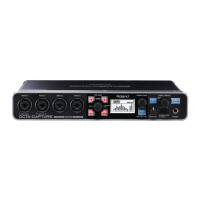63
Connecting Two OCTA-CAPTURE Units
If you connect two OCTA-CAPTURE units, you’ll be able to use them as a 24-in/20-out audio interface
with ASIO on Windows or with Core Audio on Mac OS X.
In order to connect two OCTA-CAPTURE units and use them, you must turn on the VS EXPAND
setting of the second unit, and set both units to digitally synchronize at the same sampling
frequency.
* A maximum of two OCTA-CAPTURE units can be connected simultaneously.
Before you start making settings, disconnect both OCTA-CAPTURE units from the computer and turn
o their power.
First unit (OCTA-CAPTURE) Second unit (OCTA-CAPTURE EXP)
COAXIAL OUT (9/10)COAXIAL IN (9/10)
Coaxial Cable
14 2 3
5
6 6
9
7
7
VS EXPAND: OFF
DIGITAL: AUTO
SAMPLE FREQ:
Same settings as second unit
VS EXPAND: ON
DIGITAL: AUTO
8
1. Switch on the power to the second OCTA-CAPTURE unit.
The second OCTA-CAPTURE unit will be the timing master.
2. Specify the sampling frequency (p. 68).
* When using two units, they cannot be used with the 192 kHz setting.

